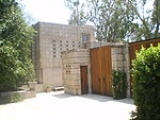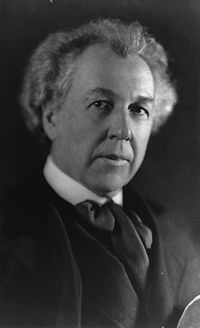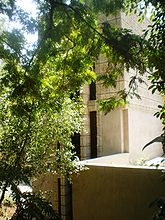
Millard House
Encyclopedia
Millard House, also known as La Miniatura, is a textile block house designed by Frank Lloyd Wright
and built in 1923 in Pasadena, California
. It was listed on the National Register of Historic Places
in 1976.
 The Millard House was the first of Frank Lloyd Wright's four "textile block" houses — all built in Los Angeles County in 1923 and 1924. Wright took on the Millard House following his completion of the Hollyhock House
The Millard House was the first of Frank Lloyd Wright's four "textile block" houses — all built in Los Angeles County in 1923 and 1924. Wright took on the Millard House following his completion of the Hollyhock House
in Hollywood and the Imperial Hotel
in Japan.
By this time, Wright felt typecast as the Prairie house architect and sought to broaden his architectural vision. Wright turned to the concrete block as his new building material. Wright wrote in his autobiography that he chose to build with concrete blocks as they were "the cheapest (and ugliest) thing in the building world," and he wanted to see "what could be done with that gutter-rat." The textile-block houses were named for their richly textured brocade
-like concrete walls. The style was an experiment by Wright in modular housing
; he sought to develop an inexpensive and simple method of construction that would enable ordinary people to build their own homes with stacked blocks. By adding ornamental designs to mass-produced blocks, Wright hoped the blocks could become a "masonry fabric capable of great variety in architectural beauty." One writer has described Wright's concept this way: "By unifying decoration and function, exterior and interior, earth and sky — perforated blocks served as skylights — Wright saw his Textile Block Method approach as an utterly modern, and democratic, expression of his organic architecture ideal."
 Wright was commissioned to build Millard House by Alice Millard, a rare-book dealer for whom Wright had built a home in Highland Park, Illinois
Wright was commissioned to build Millard House by Alice Millard, a rare-book dealer for whom Wright had built a home in Highland Park, Illinois
in 1906. Seeking to integrate the Millard House with the land, Wright designed the home to cling to the lot's steep ravine, nestled it among the trees, and fabricated the home's concrete blocks using sand, gravel and minerals found on the property. By using roughly textured, earth-toned blocks, he sought to blend the house with the color and form of the trees and hillside. While the design was in most ways a departure from Wright's prior work, it was consistent with his lifelong love of natural materials and his belief that buildings should complement their surroundings. He later said that Millard House "belonged to the ground on which it stood."
The blocks were created in wooden molds with patterns on the outside and smooth on the inside. The blocks feature a symmetrical pattern of a cross with a square in each corner. Wright reinforced the blocks using conventional mortar. The project cost $17,000 — 70% more than the $10,000 budget Millard had given to Wright. Some accounts state that the builder walked off the job, "leaving Wright to finish the project himself, out of his own pocket."
The 2400 square feet (223 m²) house consists of a vertical three-story block. The first floor has the kitchen, servant's room and a dining room opening onto a terrace with a reflecting pool. The second floor has the main entrance, guest room, and a two-story living room with a fireplace and balcony. The third floor contained Millard's bedroom with a balcony overlooking the living room and outdoor terrace.
Like many of Wright's homes, Millard House suffered from leaks during rains. After the house flooded in a storm, Millard wrote a letter to Wright complaining about the inadequate storm drain that resulted in the basement filling entirely with muddy water and the water rising to six inches (152 mm) in the dining room.
Millard added a separate studio in 1926, designed by Wright's son, Lloyd Wright
.
 The initial critical response to Millard House and the textile block structures was not positive. The homes were greeted with "howls of laughter", as Beaux Arts-trained architects were "appalled" to see a common building material used for the facades and interior walls of expensive homes. As The New York Times later said of the California houses built by Wright in the 1920s: "It didn’t help that he was obsessed at the time with an untested and (supposedly) low-cost method of concrete-block construction. What kind of rich person, many wondered, would want to live in such a house? Aside from the free-spirited oil heiress Aline Barnsdall
The initial critical response to Millard House and the textile block structures was not positive. The homes were greeted with "howls of laughter", as Beaux Arts-trained architects were "appalled" to see a common building material used for the facades and interior walls of expensive homes. As The New York Times later said of the California houses built by Wright in the 1920s: "It didn’t help that he was obsessed at the time with an untested and (supposedly) low-cost method of concrete-block construction. What kind of rich person, many wondered, would want to live in such a house? Aside from the free-spirited oil heiress Aline Barnsdall
, with whom he fought constantly, his motley clients included a jewelry salesman, a rare-book dealing widow and a failed doctor."
However, Wright himself took great pride in Millard House. He said of it: "I would rather have built this little house than St. Peter's
in Rome." Over the years, critical views of Millard House became positive, and it is now considered one of Wright's finest works.
In 1965, the Los Angeles Times columnist Art Seidenbaum wrote: "Environmentally, the place is fascinating because it still looks modern in a neighborhood that is gracious but aging. Or, maybe better, the Millard house is of no time and its own place."
In 1969, Millard House was ranked as one of the 12 most significant landmarks in the Los Angeles area by a panel of ten distinguished citizens and architecture experts.
In 1980, The New York Times noted that the Millard House was known around the world and ranked it among the few buildings in Los Angeles that "have become classic works of the 20th Century."
Frank Lloyd Wright
Frank Lloyd Wright was an American architect, interior designer, writer and educator, who designed more than 1,000 structures and completed 500 works. Wright believed in designing structures which were in harmony with humanity and its environment, a philosophy he called organic architecture...
and built in 1923 in Pasadena, California
Pasadena, California
Pasadena is a city in Los Angeles County, California, United States. Although famous for hosting the annual Rose Bowl football game and Tournament of Roses Parade, Pasadena is the home to many scientific and cultural institutions, including the California Institute of Technology , the Jet...
. It was listed on the National Register of Historic Places
National Register of Historic Places
The National Register of Historic Places is the United States government's official list of districts, sites, buildings, structures, and objects deemed worthy of preservation...
in 1976.
Wright's textile block houses

Hollyhock House
The Aline Barnsdall Hollyhock House is a building in the East Hollywood neighborhood of Los Angeles, California, originally designed by Frank Lloyd Wright as a residence for oil heiress Aline Barnsdall, built in 1919–1921...
in Hollywood and the Imperial Hotel
Imperial Hotel, Tokyo
The Imperial Hotel, Tokyo, Japan, was created in the late 1880s at the request of the Japanese aristocracy to cater to the increasing number of western visitors to Japan. The hotel site is located just south of the Imperial Palace grounds, next to the previous location of the Palace moat...
in Japan.
By this time, Wright felt typecast as the Prairie house architect and sought to broaden his architectural vision. Wright turned to the concrete block as his new building material. Wright wrote in his autobiography that he chose to build with concrete blocks as they were "the cheapest (and ugliest) thing in the building world," and he wanted to see "what could be done with that gutter-rat." The textile-block houses were named for their richly textured brocade
Brocade
Brocade is a class of richly decorative shuttle-woven fabrics, often made in colored silks and with or without gold and silver threads. The name, related to the same root as the word "broccoli," comes from Italian broccato meaning "embossed cloth," originally past participle of the verb broccare...
-like concrete walls. The style was an experiment by Wright in modular housing
Modular home
Modular buildings and modular homes are sectional prefabricated buildings or houses that consist of multiple modules or sections which are built in a remote facility and then delivered to their intended site of use...
; he sought to develop an inexpensive and simple method of construction that would enable ordinary people to build their own homes with stacked blocks. By adding ornamental designs to mass-produced blocks, Wright hoped the blocks could become a "masonry fabric capable of great variety in architectural beauty." One writer has described Wright's concept this way: "By unifying decoration and function, exterior and interior, earth and sky — perforated blocks served as skylights — Wright saw his Textile Block Method approach as an utterly modern, and democratic, expression of his organic architecture ideal."
Design of Millard House

Highland Park, Illinois
Highland Park is a suburban municipality in Lake County, Illinois, United States, about north of downtown Chicago. As of 2009, the population is 33,492. Highland Park is one of several municipalities located on the North Shore of the Chicago Metropolitan Area.-Overview:Highland Park was founded...
in 1906. Seeking to integrate the Millard House with the land, Wright designed the home to cling to the lot's steep ravine, nestled it among the trees, and fabricated the home's concrete blocks using sand, gravel and minerals found on the property. By using roughly textured, earth-toned blocks, he sought to blend the house with the color and form of the trees and hillside. While the design was in most ways a departure from Wright's prior work, it was consistent with his lifelong love of natural materials and his belief that buildings should complement their surroundings. He later said that Millard House "belonged to the ground on which it stood."
The blocks were created in wooden molds with patterns on the outside and smooth on the inside. The blocks feature a symmetrical pattern of a cross with a square in each corner. Wright reinforced the blocks using conventional mortar. The project cost $17,000 — 70% more than the $10,000 budget Millard had given to Wright. Some accounts state that the builder walked off the job, "leaving Wright to finish the project himself, out of his own pocket."
The 2400 square feet (223 m²) house consists of a vertical three-story block. The first floor has the kitchen, servant's room and a dining room opening onto a terrace with a reflecting pool. The second floor has the main entrance, guest room, and a two-story living room with a fireplace and balcony. The third floor contained Millard's bedroom with a balcony overlooking the living room and outdoor terrace.
Like many of Wright's homes, Millard House suffered from leaks during rains. After the house flooded in a storm, Millard wrote a letter to Wright complaining about the inadequate storm drain that resulted in the basement filling entirely with muddy water and the water rising to six inches (152 mm) in the dining room.
Millard added a separate studio in 1926, designed by Wright's son, Lloyd Wright
Lloyd Wright
Frank Lloyd Wright, Jr. , commonly known as Lloyd Wright, was an American landscape architect and architect, most active in Los Angeles and Southern California...
.
Critical response

Aline Barnsdall
Louise Aline Barnsdall was an American oil heiress, best known as Frank Lloyd Wright's client for the Hollyhock House in Los Angeles, now the centerpiece of the city's Barnsdall Art Park.- Biography :...
, with whom he fought constantly, his motley clients included a jewelry salesman, a rare-book dealing widow and a failed doctor."
However, Wright himself took great pride in Millard House. He said of it: "I would rather have built this little house than St. Peter's
St. Peter's Basilica
The Papal Basilica of Saint Peter , officially known in Italian as ' and commonly known as Saint Peter's Basilica, is a Late Renaissance church located within the Vatican City. Saint Peter's Basilica has the largest interior of any Christian church in the world...
in Rome." Over the years, critical views of Millard House became positive, and it is now considered one of Wright's finest works.
In 1965, the Los Angeles Times columnist Art Seidenbaum wrote: "Environmentally, the place is fascinating because it still looks modern in a neighborhood that is gracious but aging. Or, maybe better, the Millard house is of no time and its own place."
In 1969, Millard House was ranked as one of the 12 most significant landmarks in the Los Angeles area by a panel of ten distinguished citizens and architecture experts.
In 1980, The New York Times noted that the Millard House was known around the world and ranked it among the few buildings in Los Angeles that "have become classic works of the 20th Century."
See also
- List of Registered Historic Places in Los Angeles County, California
- Ennis HouseEnnis HouseThe Ennis House is a residential dwelling in the Los Feliz neighborhood of Los Angeles, California, USA, south of Griffith Park. The home was designed by Frank Lloyd Wright for Charles and Mabel Ennis in 1923, and built in 1924....
, Samuel Freeman HouseSamuel Freeman HouseSamuel Freeman House is a Frank Lloyd Wright house in the Hollywood Hills of Los Angeles built in 1923. As an example of Wright's pre-Columbian or early Modernist architecture, the structure is noteworthy as one of the four textile block houses built by Wright in the Los Angeles area, the other...
and Storer House — Wright's other three textile block houses

